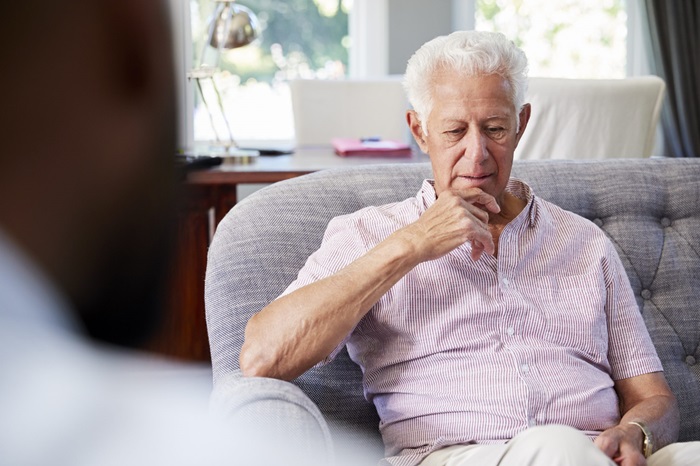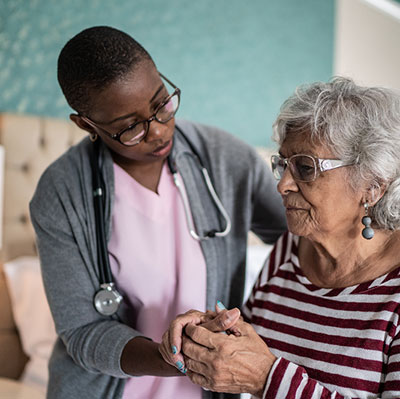I Have Parkinson’s Disease. Now What?

September 15, 2021
Parkinson’s Disease is a progressive disorder of the brain and spinal cord typically found in people age 60 and older. The disease commonly starts with a tremor in one hand and can result in slowed movement, stiffness, loss of facial movement and changes in walking pattern.
Other symptoms of Parkinson’s can include pain in a specific area or throughout your body, cognitive decline, problems sleeping, speech and swallowing problems, constipation and loss of smell.
After receiving a diagnosis of Parkinson’s, many patients come to their physician with the same questions.
Roger P. Rossi, D.O., director of the Parkinson’s and Movement Disorders program at JFK Johnson Rehabilitation Institute, shared his answers to the top six most frequently asked questions after diagnosis.
Could this be a misdiagnosis?
Because symptoms of Parkinson’s gradually develop over time, early-stage symptoms may be mild, causing some people to question their diagnosis.
“There isn’t a single test to determine if someone has Parkinson’s. A neurologist will perform a physical and neurological examination, review your medical history as well as your present symptoms,” shares Dr. Rossi.
“In determining a positive diagnosis, doctors will look for three or four symptoms consistent over a period of time – resting tremor, stiffness or rigidity, and slowness of movement, as well as gait and balance problems.”
There is also a test called the DaT (dopamine transport uptake assessment), which assesses a part of the brain to see if the chemical dopamine is sufficient in that area. In Parkinson’s cases, the dopamine-producing neurons die, which then can result in the various symptoms related to body movement.
“The diagnosis of Parkinson’s disease remains a clinical diagnosis. Between an analysis of the patient’s genetic history, a neurological examination, and if needed, a DaT scan, the diagnosis is reliably accurate,” Dr. Rossi adds.
How will Parkinson’s affect my day-to-day life?
“Parkinson’s is not a fatal disease. Proper medication management, lifestyle modification, exercise, and therapies, are all ways to manage the disease, control symptoms and influence disease progression so one can continue doing the things they enjoy,” shares Dr. Rossi.
Some people experience secondary effects of the disease, though, like depression and anxiety.
“If you’re stressed or going through different life events, symptoms can worsen,” says Dr. Rossi. “It’s really important that you have a team of caregivers you trust, and it helps to get involved in the Parkinson’s community, such as support groups or community walks and events. These events and groups can offer much needed support and understanding when you need it most.”
How will the disease progress?
“There are five classic stages of Parkinson’s. From stage one, a tremor may present itself on one hand. The patient may start to experience rigidity, altered walking, difficulty performing daily activities, and loss of facial expression.
At stage five, the symptoms can be as extreme as having difficulty swallowing, or bed bound,” shares Dr. Rossi. “This disease progresses differently for everyone; for some it may advance much quicker, and for others, they may experience symptoms worsening over 10 to 20 years.”
When do I need to take medication for Parkinson’s?
Patients commonly ask, ‘When is the best time to start taking medications?’ That always comes down to the individual patient, their needs, and how their symptoms are progressing.
“There’s also the common concern that if you start taking medications, they’ll eventually stop being effective,” mentions Dr. Rossi. “But in reality, the most important thing to focus on is working with your doctor to identify the right prescriptions, and administering them on time.”
Unfortunately, there is no cure for Parkinson’s. However, the combination of medications and other therapy (such as exercise, strength training and balance and gait training) can help patients manage symptoms.
Overall, you want to be careful about how much of your medication you’re using. If you’re taking too much you could get orthostatic hypotension (a form of low blood pressure that happens when you go from sitting or lying down to standing), dizziness, vertigo, confusion, falling, and increased involuntary movements called dyskinesias.
“Also, the timing is crucial so that you do not have drastic changes in symptoms. For example, if your medication is due at 6 p.m., you want to make sure you take it on time, if you don’t, you could have difficulty walking, or start to get stuck, or frozen,” says Dr. Rossi.
Could I have prevented this?
“Unfortunately, since the cause of Parkinson’s is unclear, there is no proven way to prevent the disease. However, regular physical exercise is thought to reduce your chances of developing the disease,” mentions Dr. Rossi.
“Whether you enjoy swimming, cycling, jogging, Pilates or our unique Rock Steady Boxing program, exercise can help delay the onset of Parkinson’s and help manage symptoms and progression.”
What do I do now?
Find the right team who can support all of your needs, Dr. Rossi says.
Within the past 10 to 15 years, there has been a significant emphasis on complementary therapies like exercise, strength training and balance and gait training.
“Other strategies like cognitive, behavioral and occupational therapies can also help people with Parkinson’s, so it’s really important to have a team who can do it all,” Dr. Rossi adds.
Next Steps & Resources:
- Meet our source: Roger P. Rossi, D.O.
- To make an appointment with a doctor near you, call 800-822-8905 or visit our website.
The material provided through HealthU is intended to be used as general information only and should not replace the advice of your physician. Always consult your physician for individual care.







